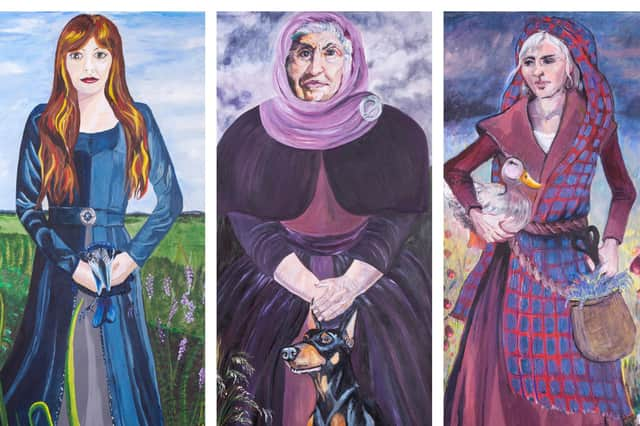Portraits of Scottish witches revealed


The women were all put to death in Dalkeith in 1661, when a number of witchcraft trials were held across the Lothians, after accusations of witchcraft and sorcery were made against them.
Dalkeith Arts has selected the stories of six women to illustrate the witch panic of the 15th and 16th Century and how it impacted the town. Around 30 women were tried in Dalkeith in total.
Advertisement
Hide AdAdvertisement
Hide AdThe portraits will now be hung in the town centre as a “beautiful visualisation of a horrible epoch” in Dalkeith’s history.
Among those women now illustrated is Beatrix Leslie, who was accused of causing the collapse of a coal pit. Her trial also heard that she was involved in folk healing and midwifery, but she insisted her skills in helping others give birth were legitimate. She was often involved in neighbourly disputes, with the death of her cat at the root of much trouble.
After being found guilty, she was strangled and burned on September 3, 1661. It is believed she was aged 83 or 84 at the time.
The case of Christian Patersone has also been highlighted by the project. A widow, she was executed after apparently giving a very detailed confession about changing the devil from a beast to a man in order to have sex with him.
Her trial heard that she was present at witches meetings and also had an interest with folk culture .
Issobell Fergussone was put on trial in Dalkeith on July 3 1661, where it is claimed she spoke of adultery and fornication at a meeting with the devil. She was also accused of verbal threats against her neighbors and son. She was executed aged 71.
The three other women accused of witchcraft and now immortalised in the town are Jenet Davidson, Janet Cook and Katherine Casse.
Mary Blair, of Dalkeith Arts, said the portraits of the women had been produced over lockdown the help of Scottish Government community funding.
Advertisement
Hide AdAdvertisement
Hide AdShe added: said: “It is hoped that they will make a powerful statement of the continued commitment of local people and groups throughout this difficult time to improving Dalkeith town centre and honouring its history.”
She said the impact of the witchcraft tria’s in the town would likely be “quite shocking” for some.
"This is a reality check, it is not just a gruesome story. These portraits are also a memorial to what took place in a very turbulent economic and political climate and how a certain group of people became the target of everyone’s anxiety.”
The panels will go on display in mid October.
Witch hunting came in various waves across Scotland after the passing of the Witchcraft Act in 1563, which made witchcraft, or consulting with witches, capital crimes.
Records detail witchcraft charges against some 4,000 Scots, the overwhelming majority of them women
The 1563 Act was repealed in 1736 but superstition, traditions and stories surrounding witchcraft lingered on long thereafter.